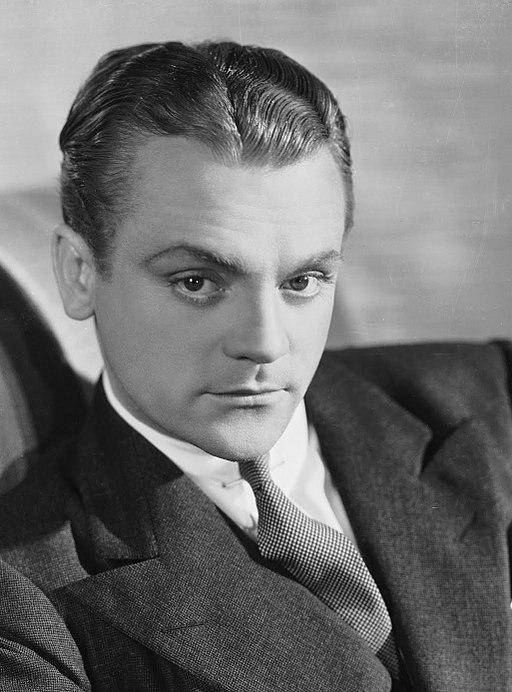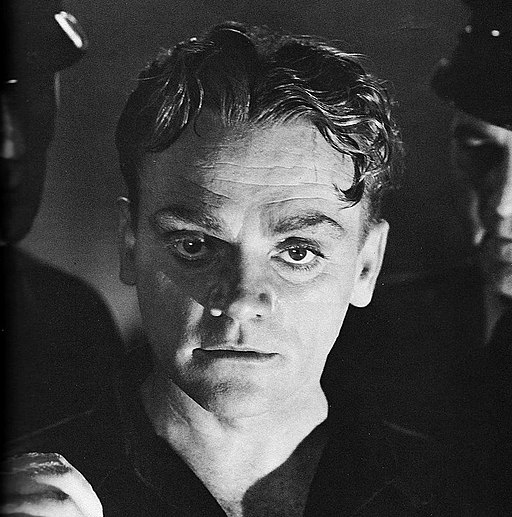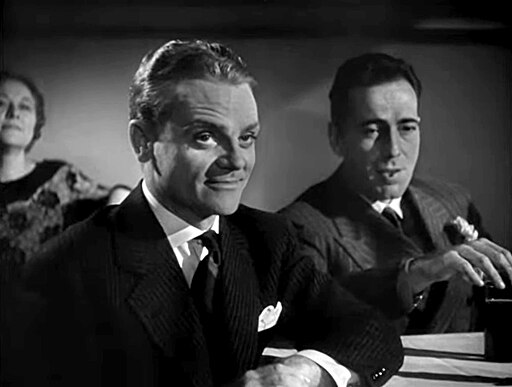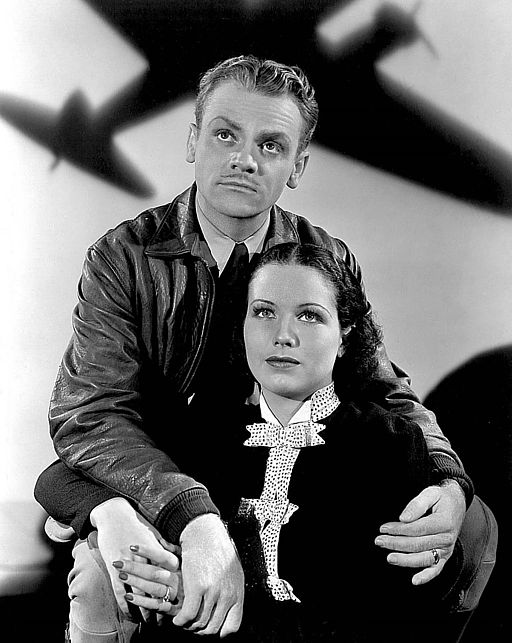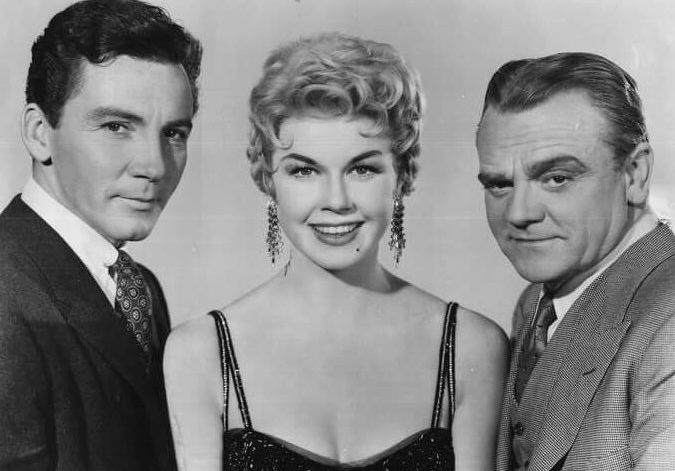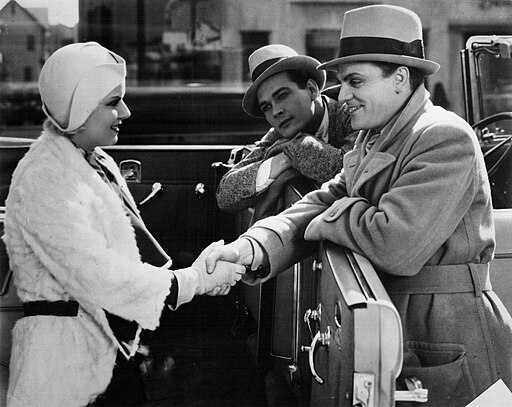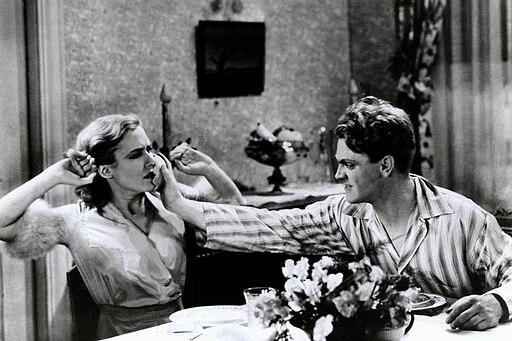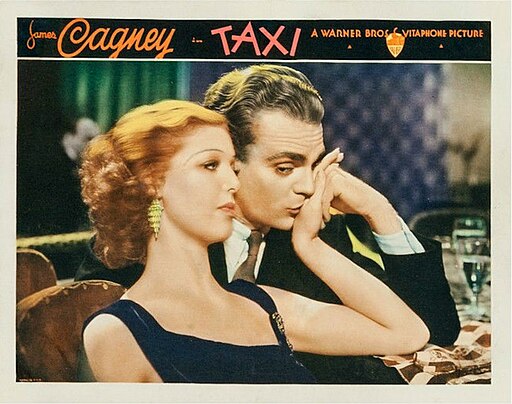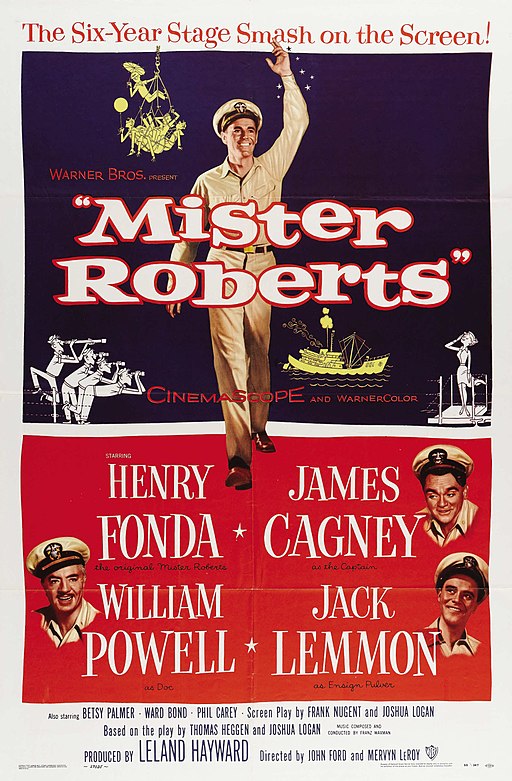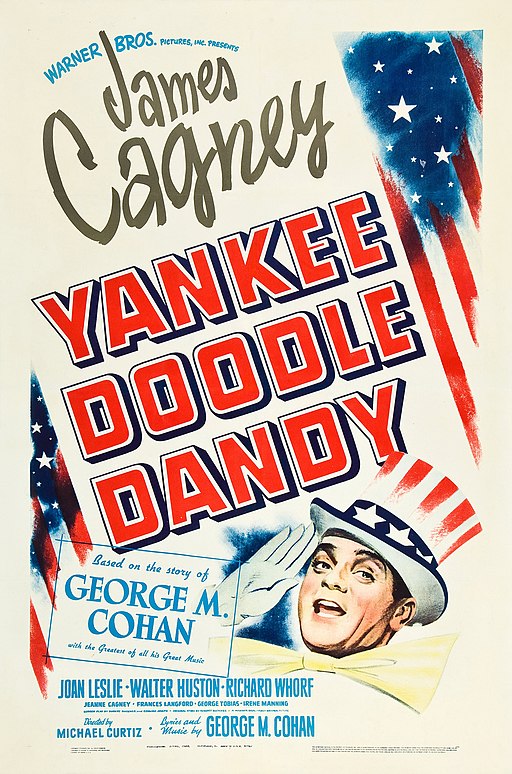James Cagney
back| Full Name | James Francis Cagney Jr. |
| Stage Name | James Cagney |
| Born | July 17, 1899 |
| Birthplace | New York City, U.S. |
| Died | March 30, 1986 |
| Buried | Gate of Heaven Cemetery, Hawthorne, New York, U.S. |
| Married to | Frances Vernon Cagney (née Willard) from 1922 until his death in 1986 |
| Children | James Cagney Jr. and Cathleen Cagney |
| Notable films | The Public Enemy (1931) _ Yankee Doodle Dandy (1942) - White Heat (1949) - Mister Roberts (1955) - Run for Cover (1955) |
James Cagney
The Professional Againster
James Cagney (1899-1986) was a renowned American actor, celebrated for his dynamic and versatile performances in the golden era of Hollywood. Born in New York City, Cagney began his career in vaudeville and Broadway before transitioning to film. He gained stardom in 1931 with his breakthrough role as a tough gangster in "The Public Enemy," which established him as a leading figure in the gangster genre. Cagney's energetic style, distinctive voice, and tough persona were hallmarks of his career, but he also showcased remarkable versatility in musicals and dramas.
His portrayal of George M. Cohan in "Yankee Doodle Dandy" (1942) earned him an Academy Award for Best Actor, highlighting his talent in song-and-dance roles. Other notable films include "White Heat" (1949) and "Angels with Dirty Faces" (1938). Despite being typecast as a gangster, Cagney's ability to handle a variety of roles demonstrated his extensive acting range.
James Cagney was often nicknamed "The Professional Againster," for his frequent portrayal of tough, rebellious characters who often went against the grain, challenging authority and societal norms.
Related
James Cagney
Biography and Analysis of his Movie Career
Early Life
Cagney was born in the Lower East Side of Manhattan, New York City. He was the second of seven children. His father was of Irish descent, and his mother was of Norwegian and Irish ancestry. Growing up in a rough neighborhood, Cagney quickly learned to defend himself and developed a sense of street smarts.
Career Beginnings
Cagney started his acting career in vaudeville and Broadway. He made his film debut in the 1930 film "Sinner's Holiday." He gained fame for his role as a criminal in "The Public Enemy" (1931), which established him as a tough-guy actor.
Hollywood Stardom
Cagney became one of Hollywood's leading actors in the 1930s and 1940s, known for his energetic and often brash portrayals. He starred in a variety of genres, including musicals, dramas, and comedies. His portrayal of George M. Cohan in "Yankee Doodle Dandy" (1942) won him an Academy Award for Best Actor.
Later Career and Retirement
In the 1950s, Cagney's career slowed down, but he still delivered powerful performances, notably in "White Heat" (1949) as the psychotic gangster Cody Jarrett. He retired from acting in the early 1960s but made a comeback in the 1981 movie "Ragtime," his final film appearance.
Personal Life and Legacy
Cagney was married to Frances Vernon Cagney for 64 years. They adopted a son, James Cagney Jr., and later a daughter, Cathleen Cagney. He was known for his philanthropic efforts, particularly in supporting and nurturing young talent in the film industry.
Cagney passed away in 1986 at his farm in Stanfordville, New York, due to a heart attack. He left behind a legacy as one of the most versatile and skilled actors of his generation, remembered for both his tough-guy roles and his song-and-dance performances.
Trivial Questions about James Cagney:
How Tall Was James Cagney?
James Cagney was approximately 5 feet 5 inches (165 cm) tall. His relatively modest height was notable in Hollywood, especially given the larger-than-life characters he often portrayed on screen. Despite this, Cagney's dynamic presence and commanding performances made him one of the most formidable actors of his time.
Did James Cagney have a Limp in real Life?
James Cagney did not have a real-life limp. His distinctive, energetic walk in films was part of his acting style rather than a result of any physical impairment.
Cagney's walk, often described as a kind of strut, added to the toughness and charisma of the characters he portrayed, especially in his gangster roles. This unique gait became one of his trademarks, contributing to his on-screen persona and helping to establish his reputation as one of Hollywood's iconic actors.
Analysis of James Cagney’s Style of Acting:
James Cagney's acting style was distinguished by a unique combination of intensity, versatility, and naturalism, which helped him stand out in the golden age of Hollywood. His approach to acting was shaped by several key elements:
- Energetic Physicality: Cagney was known for his dynamic physical presence on screen. He moved with a distinctive briskness and often incorporated vigorous gestures and rapid movements. This physicality was especially evident in his dance sequences, where he displayed surprising agility and rhythm, despite his tough-guy image.
- Tough-Guy Persona: One of Cagney's most iconic contributions to film was his portrayal of tough, streetwise characters. He often played gangsters or hard-edged individuals with a no-nonsense attitude. His characters typically displayed a blend of toughness and charm, a combination that made them both formidable and likable.
- Emotional Range and Depth: Cagney had the ability to convey a wide range of emotions effectively. He could transition seamlessly from charming and lighthearted to intense and menacing. This emotional versatility allowed him to excel in various genres, from gangster films to musicals and comedies.
- Naturalistic Approach: Cagney's acting was grounded in realism. He avoided over-the-top theatrics, instead opting for a more naturalistic portrayal of characters. His dialogue delivery was noted for being direct, crisp, and authentic, often delivered with his distinctive New York accent.
- Improvisational Skill: Cagney was known for his ability to improvise, bringing a sense of spontaneity and freshness to his performances. He often ad-libbed lines or added personal touches to his characters, making each role uniquely his own.
- Song and Dance Talent: Apart from his acting, Cagney was also an accomplished dancer and singer. His performance in "Yankee Doodle Dandy" showcased his exceptional talent in musical theatre, a stark contrast to his gangster roles. This versatility broadened his appeal and demonstrated his multifaceted talent.
- Influence of Early Career: Cagney's early career in vaudeville and Broadway significantly influenced his acting style. The theatrical and expressive techniques he learned on stage helped shape his dynamic screen presence.
- Subtlety and Complexity: In his more mature roles, Cagney displayed a remarkable ability to convey complex emotions and internal conflicts. He adeptly portrayed characters with depth and subtlety, often revealing vulnerability beneath a tough exterior.
Cagney's style influenced future generations of actors, particularly those portraying anti-heroes or complex character roles. His legacy in acting is marked by a blend of charisma, intensity, and authenticity, making him one of the most enduring figures in American cinema.
Memorable Quotes from James Cagney:
"You dirty rat!"
Often misquoted as "You dirty rat, you killed my brother!" this line is one of the most famous misattributed to Cagney. He never actually said it in any of his films, but it's widely associated with his gangster persona.
"Made it, Ma! Top of the world!"
From "White Heat" (1949), this line is delivered by Cagney's character, Cody Jarrett, during the film's climactic ending. It's one of the most famous scenes in classic cinema.
"My mother thanks you. My father thanks you. My sister thanks you. And I thank you."
This line is from "Yankee Doodle Dandy" (1942), where Cagney portrayed the legendary entertainer George M. Cohan. The film showcased Cagney's range, proving he was not just a tough-guy actor but also a talented song-and-dance man.
"One thing I learned in the can is that you gotta fight dirty. If you wanna win, you gotta fight dirty."
From "White Heat," this line reflects the gritty, ruthless nature of Cagney's character, a gangster with few, if any, scruples.
"Is this the end of Rico?"
Although this line is actually from Edward G. Robinson in the film "Little Caesar" (1931), it's often mistakenly attributed to Cagney due to his strong association with the gangster genre.
"A copper, a copper. How do you like that, boys? A copper. And I trusted him."
In "The Public Enemy" (1931), this line reflects the betrayal felt by Cagney's character, Tom Powers, one of his most iconic roles.
Awards and Nominations:
James Cagney's illustrious career in Hollywood was recognized with various awards and nominations, reflecting his significant impact on the film industry. Here's an overview of his major awards and nominations:
Academy Awards
- Winner: Best Actor for "Yankee Doodle Dandy" (1942).
- Nominated: Best Actor for "Angels with Dirty Faces" (1938).
- Nominated: Best Actor for "Love Me or Leave Me" (1955).
Other Honors and Awards
- AFI Life Achievement Award: In 1974, Cagney was awarded the American Film Institute's Lifetime Achievement Award, recognizing his contributions to enriching American culture through motion pictures.
- Kennedy Center Honors: In 1980, he was a recipient of this prestigious award, which celebrates lifetime contributions to American culture through the performing arts.
- Screen Actors Guild Lifetime Achievement Award: Cagney received this honor in 1979, acknowledging his career achievements and humanitarian accomplishments.
- New York Film Critics Circle Award: He won the Best Actor award for "Yankee Doodle Dandy" in 1942.
- National Board of Review Award: Cagney won the Best Actor award for "Yankee Doodle Dandy" in 1942.
- Honorary Doctorate: In 1976, Cagney was awarded an Honorary Doctorate of Fine Arts by Emerson College, recognizing his contributions to the arts.
Star on the Hollywood Walk of Fame
- Cagney has a star on the Hollywood Walk of Fame for his contributions to the film industry, located at 6504 Hollywood Boulevard.
Other Nominations
- Throughout his career, Cagney received numerous other nominations for various awards, reflecting his status as one of Hollywood's most respected actors.
Why “The Public Enemy” from 1931 was so Significant for Cagney’s Career:
James Cagney's role in "The Public Enemy" (1931) was a pivotal moment in his career and had a significant impact on his future trajectory as an actor. Here's why this role was so crucial:
Breakthrough Performance: "The Public Enemy" was Cagney's first leading role in a major film and served as his breakthrough performance. Before this, he had appeared in smaller or supporting roles. His portrayal of Tom Powers, a charismatic yet brutal gangster, captured the attention of audiences and critics alike.
Establishment of Screen Persona: This film cemented Cagney's image as the quintessential "tough guy." His portrayal of a gangster with a volatile temper and a certain roguish charm became a template for similar characters he would play throughout his career. This tough-guy persona became so iconic that it overshadowed his versatility as an actor in different genres.
Critical and Commercial Success: "The Public Enemy" was both a critical and commercial success. It not only boosted Cagney's career but also helped establish Warner Bros. as a major studio in Hollywood. The film's success was a testament to Cagney's compelling screen presence and acting skills.
Influence on the Gangster Genre: Cagney's performance in "The Public Enemy" had a lasting impact on the gangster genre. He brought a certain realism and depth to his character that set a new standard for portrayal of criminals in cinema. This film, along with others like "Little Caesar" and "Scarface," defined the early 1930s gangster film era.
Controversy and Censorship: The film was controversial for its time, depicting violence and criminal activities in a stark, realistic manner. This led to increased censorship in Hollywood, but it also showed the power of film to provoke public discourse, and it established Cagney as a daring actor willing to take on edgy roles.
Typecasting Challenges: While the success of "The Public Enemy" made Cagney a star, it also typecast him as a gangster in the public eye. Despite this, he later demonstrated his range by excelling in other genres, including musicals and comedies.
Legacy and Influence: The role of Tom Powers remains one of Cagney's most memorable performances and is often referenced in discussions about classic Hollywood cinema. It contributed significantly to his legacy as one of the greatest actors of the 20th century.
In summary, James Cagney's role in "The Public Enemy" was a turning point that not only launched him into stardom but also had a lasting influence on the gangster genre and Hollywood cinema in general.
Full Overview of Movies starring James Cagney:
1930s
- 1930, "Sinner's Holiday": Cagney's film debut, playing the role of a criminal in a story about a crime family.
- 1930, "The Doorway to Hell": As a supporting character, Cagney plays a gangster's right-hand man.
- 1931, "The Millionaire": Cagney appears as a small-time hoodlum in this comedy about a millionaire in disguise.
- 1931, "Other Men's Women": A drama about love and friendship among railroad workers, with Cagney in a supporting role.
- 1931, "The Public Enemy": Cagney's breakthrough role as a bootlegger and gangster, showcasing his tough-guy persona.
- 1931, "Smart Money": Playing a supporting role alongside Edward G. Robinson in a crime film about gambling.
- 1932, "The Crowd Roars": A film about auto-racing, where Cagney plays a race car driver.
- 1932, "Winner Take All": Cagney stars as a boxer rising through the ranks.
- 1933, "Hard to Handle": A comedy where Cagney plays a fast-talking promoter.
- 1933, "Picture Snatcher": Cagney portrays an ex-gangster turned news photographer.
- 1933, "The Mayor of Hell": A drama with Cagney as a gangster helping reform a corrupt reform school.
- 1933, "Lady Killer": A comedy-crime film featuring Cagney as a movie theater usher turned Hollywood actor.
- 1933, "Footlight Parade": A musical where Cagney plays a producer putting on extravagant stage shows.
- 1934, "Jimmy the Gent": A comedy with Cagney as a crooked missing-heirs finder.
- 1934, "He Was Her Man": A romantic drama featuring Cagney as a gangster on the run.
- 1934, "Here Comes the Navy": A romantic comedy-drama with Cagney as a cocky navy sailor.
- 1935, "The St. Louis Kid": Cagney portrays a truck driver involved in labor conflicts.
- 1935, "Devil Dogs of the Air": A military drama with Cagney as a daring naval aviator.
- 1935, "G Men": Cagney takes on the role of an FBI agent in this crime film.
- 1935, "A Midsummer Night's Dream": An adaptation of Shakespeare's play, with Cagney as Bottom.
- 1936, "Ceiling Zero": A drama about aviation, starring Cagney as a daring pilot.
- 1936, "Great Guy": A crime film with Cagney as a crusading public servant.
- 1937, "Something to Sing About": A musical comedy featuring Cagney as a New York bandleader turned Hollywood star.
- 1938, "Boy Meets Girl": A comedy where Cagney plays a screenwriter in Hollywood.
- 1938, "Angels with Dirty Faces": A crime film featuring Cagney as a gangster with a childhood friend who's a priest.
- 1939, "The Roaring Twenties": A crime drama tracing the life of a World War I vet turned gangster.
- 1939, "Each Dawn I Die": Cagney stars as a reporter framed for manslaughter.
1940s
- 1940, "The Fighting 69th": A war film with Cagney as a tough, streetwise soldier.
- 1940, "Torrid Zone": A comedic adventure film featuring Cagney as a plantation manager in Central America.
- 1940, "City for Conquest": A drama about the lives of New York City slum dwellers.
- 1941, "The Strawberry Blonde": A romantic comedy with Cagney as a turn-of-the-century dentist.
- 1941, "The Bride Came C.O.D.": A romantic comedy featuring Cagney as a pilot.
- 1942, "Captains of the Clouds": A war drama about Canadian bush pilots.
- 1942, "Yankee Doodle Dandy": A musical biopic where Cagney portrays the famous entertainer George M. Cohan.
- 1943, "Johnny Come Lately": Cagney plays a drifter who helps a newspaper editor fight corruption.
- 1945, "Blood on the Sun": A spy film set in Japan, with Cagney as an American journalist.
- 1947, "13 Rue Madeleine": A World War II espionage film featuring Cagney as an OSS agent.
- 1948, "The Time of Your Life": A comedy-drama based on the William Saroyan play.
- 1949, "White Heat": A classic gangster film with Cagney as a ruthless, psychologically complex criminal.
1950s
- 1950, "The West Point Story": A musical comedy with Cagney as a Broadway director.
- 1950, "Kiss Tomorrow Goodbye": Cagney plays a ruthless criminal in this film noir.
- 1951, "Come Fill the Cup": A drama about alcoholism, with Cagney as a recovering alcoholic reporter.
- 1951, "Starlift": A cameo appearance in a musical film.
- 1952, "What Price Glory": A war film set during World War I.
- 1953, "A Lion Is in the Streets": A drama where Cagney plays a Southern politician.
- 1955, "Love Me or Leave Me": A biographical musical drama with Cagney as gangster Marty Snyder.
- 1955, "Mister Roberts": A comedy-drama about life on a cargo ship during World War II.
- 1955, "Run for Cover": A western film with Cagney as a wrongly accused man.
- 1956, "Tribute to a Bad Man": A western where Cagney plays a tough rancher.
- 1956, "These Wilder Years": A drama about a successful businessman searching for his long-lost son.
- 1957, "Man of a Thousand Faces": A biographical film about the life of silent film star Lon Chaney, with Cagney in the lead role.
1960s
- 1961, "One, Two, Three": A comedy set in West Berlin during the Cold War.
- 1968, "Arizona Bushwhackers": A cameo appearance in this western film.
1980s
- 1981, "Ragtime": Cagney's final film appearance, in a supporting role in this period drama.

